Canon EF 600mm f/4L IS II USM Hands On Impressions
Note: The lens in this review was rented from Lens Rentals.com. It was rented on my own dime for a trip to Yellowstone and Grand Teton National Parks, and not for the purpose of writing a review. However, since I had a bit more than a week with the lens, I couldn’t help myself for writing something about it.
As this lens is a rental, and not new stock bought for myself, I’m not going to do any image quality or performance testing on it. While Lens Rentals goes to great lengths to insure that their stock is in top shape and defect free, it’s still a rental lens and therefor not necessarily indicative of the performance or behavior from a single owner lens. Nor did I have the lens long enough to determine if any potential issues I might have had were due to the lens, my cameras, or just the differences in technique necessary to maximize the image quality from this lens.
For many photographers, owning one of Canon’s great white lenses (i.e., the big telephotos) is little more than a dream. Their optical performance is as close to perfection as can be expected from a manufactured item, and the build quality is second to none. If you’re a sports, wildlife, or aviation photographer, these lenses, are almost certainly a goal if not a necessity. And even if that’s not your cup of tea, there’s certainly an allure to these lenses if only due to the price tag and relative rarity.
I’ve been, and to some extent still am, in the dreaming of owning one boat. Though perhaps not nearly to the extent that I was before using EF 600mm f/4L IS II USM in the field.
I’ve been using telephoto lenses pretty much as long as I’ve been serious about photography. My third lens was a 70-300mm, and that was quickly replaced with a 100-400mm zoom, who’s successor is still my workhorse long lens. My point is, I don’t consider myself a stranger to using long lenses.
That said, a whole lot has changed since I was shooting with APS-C cameras at 400mm, and a 600mm f/4 is in a completely different size class to the 100-400mm zooms I’m use to shooting with.
For starters, resolution has continued to increase. My 5D mark IV’s 30 MP sensors have a finer, and therefore more demanding, pixel pitch than my 40D did. Aside from being more demanding of the lens itself, smaller pixels also mean camera is more sensitive to smaller movements and therefore more demanding of the IS system and shutter speeds to stop shake and motion.
Likewise, my 100-400 mark II, at 3.6 pounds, is a feather compared to the 8.6 pounds of a 600mm f/4L IS II USM. More mass is a mixed blessing. On one hand it has more inertia to overcome and therefore is harder to shake. On the other hand, it’s also heavier which means it’s that much harder to hand hold — though, I found it was possible to do for short periods — and maintain sharp images.
What I’m trying to get at here is that if you’re not use to shooting with a big heavy prime, say a 400mm f/2.8 or larger, then there is a learning curve to getting the most out of this 600mm f/4 if you’re jumping into one. That’s not to say you can’t get extremely good images out of the lens with out “training”, but the success rate and overall quality is going to be lower than you’re might be expecting.
That was maybe the biggest point I think I took away from this whole experience. While I’m perfectly comfortable that I could rent a 11-24 f/4L, or a 85mm f/1.4L, and be pretty close to using it very effectively right out of the gate. There’s a much broader learning curve with a lens like this. The size makes it just that much more unwieldly and the magnification/angle of view makes it that much more sensitive to shake and subject motion.
While I wouldn’t recommend against rent this lens, or any of it’s siblings. You need to have your eyes open going in to doing so. Moreover, I would recommend building time into your rental period to get accustomed to the lens before you get to when you really need it.
Image and Build Quality; The Broad Strokes
Resistant
Since this was a rental lens, I didn’t look at image quality other than to make sure it seemed sharp on my bodies. As a result, I don’t have anything to report on image quality in this review.
However, build quality is something that I can make some reasonable comments about from handling a rental lens — ignoring the wear on the finish that comes from a rental lens of course.
The lens is built like you would expect form a $12,000 flagship still lens; very well. There’s pretty much nothing when it comes to build that I can really complain about. If you’ve used any of Canon’s L series lenses, the EF 600mm f/4L IS II USM is built every bit as good and then some.
For example, Canon’s super-telephoto primes have some of the best weather sealing that Canon puts in a lens. I’ve met photographers who use these lenses, in conjunction with a 1D series camera, in pouring rain without any kind of rain cover or protection and they’ve done so for years. Though admittedly I wouldn’t do that, and I certainly wasn’t interested in testing the weather sealing of a rental lens, that’s the standard that these lenses are built to.
Unique Features and Functions
Canon’s super-telephoto lenses have a number of unique features that aren’t found on other Canon lenses. Primarily these are the AF stop buttons, focus pre-sets, and power focus mode.
AF Stop Buttons
The EF 600mm f/4L IS II USM has 4 AF stop buttons located around the circumference of the front of the lens. By default, pressing and holding these buttons will stop the camera from autofocusing. This can be useful if you don’t use rear button focusing, and want to stop the servo AF from running while shooting a static subject.
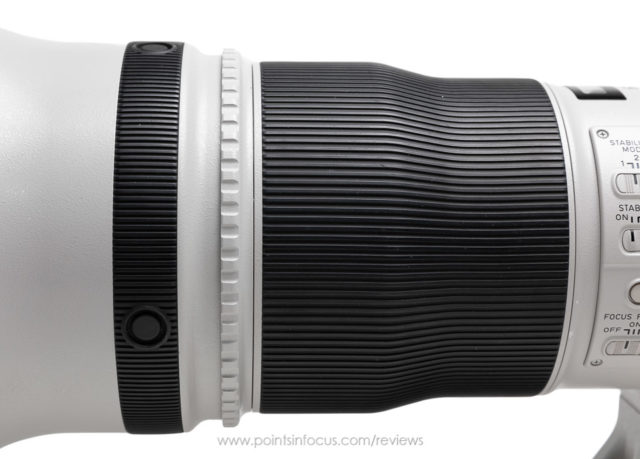
However, with modern DLSRs, the function of these buttons can be changed to potentially be more useful for the photographer. On the 1DX mark II and 5D mark IV this button can be set to any of the following functions:
- Metering and AF start
- AF stop
- Switch to registered AF function
- switch between One Shot and AI servo modes
- Switch to registered AF point
- Pause Movie Servo AF (1DX mark II only)
- AE Lock
- AE Lock Hold
- IS Start
In the short time I had working with the 600mm f/4L, I honestly didn’t find a use for these buttons. Though most of that was down to limited time working with the lens and not so much a commentary on the utility. There are certainly situations and places where I can see a lot of utility in this. Especially the 1DX’s ability to pause movie servo.
Focus Preset
Another unique function is Focus Preset. When enabled, the user can save any arbitrary focus position and restore that focus position by turning the playback ring.
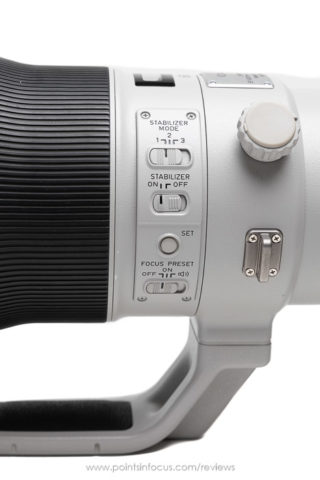
The intent for this feature is to enable rapid pre-focusing at a consistent distance for faster AF acquisition.
The utility of this function is going to be heavily dependent on the subject matter you’re shooting. It works best for subjects that repeatedly pass through a relatively fixed point (e.g., cars going around a curve on a race track). For the kinds of wildlife shooting that I was doing, where nothing really stayed at a consistent distance, the function wasn’t at all useful to me.
However, like the AF stop buttons, there’s a lot of potential utility in this if it fits with your kind of shooting.
I do want to point out one point to be aware of. If Focus Preset mode is enabled, and you rotate the playback ring the lens goes into MF mode while it’s focusing to the pre-set distance. If you happen to keep the ring rotated, the lens will stay in “MF mode” and continue to stay focused at the pre-set distance. While this is the intended behavior, it can lead to some head scratching as to why the camera isn’t focusing if you’re not aware of what’s happening.
In my specific case, when I first started working with the 600 f/4 I thought that the AF Preset functionality sounded useful, so I left the switch enabled. While I was shooting, occasionally I would find that the camera wasn’t focusing and my 5D mark IV would display “M Focus” in the viewfinder.
I was resting my hand on the top of the of the lens to stabilize it and was inadvertently slightly turning the Playback ring. This was causing the lens to return to the pre-set position and since I was holding the ring turned, tell the camera was in MF mode and no longer focusing as I intended. Needless to say this was very confusing to me as looking at the lens’s focus mode switch would show the lens in AF mode not MF mode as was being reported in my viewfinder.
Suffice to say, after some head scratching, I realized I was turning the playback ring and turned off the Focus Preset mode. While there may have been situations where I could have used it, it was far better for me to not have focusing issues from accidentally rotating the playback ring.
Power Focus (PF) Mode
The final unique feature to these lenses is Power Focus mode. Power Focus is enabled by setting the focus mode switch to PF. When enabled, the Playback ring on the front of the lens will cause the AF system to smoothly shift focus. The speed of the focus rack is controlled by the amount the playback ring is turned. The direction of focus rack is controlled by the direction the playback ring is turned; which matches the directions of the regular manual focus ring.
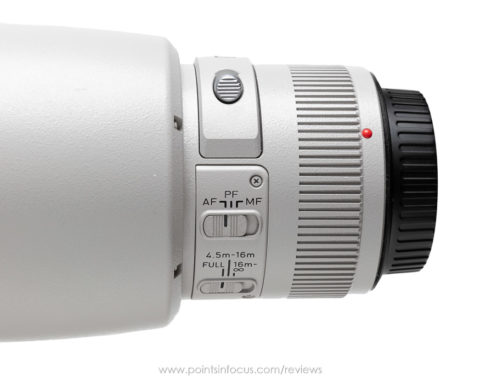
This is very much a video oriented feature, as there’s no reason to do this while shooting stills. However, for rack focus moves while shooting video it does function reasonably well. In fact, with more people shooting video with Canon’s still lenses, I would even go so far as to argue that Canon should find a way to integrate this mode to more of their lenses.
As a side note, like the Focus Preset mode, while the lens is racking focus under Power Focus, it reports to the camera that it’s in manual focus mode. If you have the current AF mode displayed in the viewfinder, as you can do on the 5D4 and 1DX II, you’ll see M Focus while the focus is being adjusted.
Filters
With a nearly 6 inch (~150 mm) diameter front element, using front mounted filters with the 600mm f/4L would be impractical at best. Instead, the EF 600mm f/4L IS II USM uses a drop in filtering solution that mounts the filter internally to the lens.
Since the filter is internal to the lens, the optical design of the lens is such that it requires a glass filter to be installed to insure proper focus. Canon supplies the lens with a gelatin filter holder — 52(WII) — that satisfies these conditions and allows the use of gelatin filters.
Additionally a drop in circular polarizer unit — PL-C52(WII) — and a holder for standard 52mm screw in filters is also available for use with, for example, solid ND filters. The PL-C52(WII) polarizer holder includes a thumb wheel that enables the user to rotate the polarizer’s orientation without having to remove the filter holder.
The only real downside to the 600 f/4’s filtration situation is that you’re more or less limited to the types and brands of filters you can use. Specifically if you’re looking at using the circular polarizer. Canon’s CPL is reportedly very good, but they don’t appear to publish much information on it so it’s hard to compare with other makes — not that you can effectively use those with this lens anyway.
Cap and Hood
As one can imagine, the hood that comes with the EF 600mm f/4L IS II USM is huge. It’s large and well made, and costs $700 to replace if you manage to break it.
The hood mounts and locks in place with a thumb-screw locking mechanism instead of the more common bayonet arrangement. When in place and secure the hood is very solid, and can easily support the entire weight of the lens and a camera if you set it down that way. When not in use, the hood can be reversed and stored over the front of the lens — like most hoods.
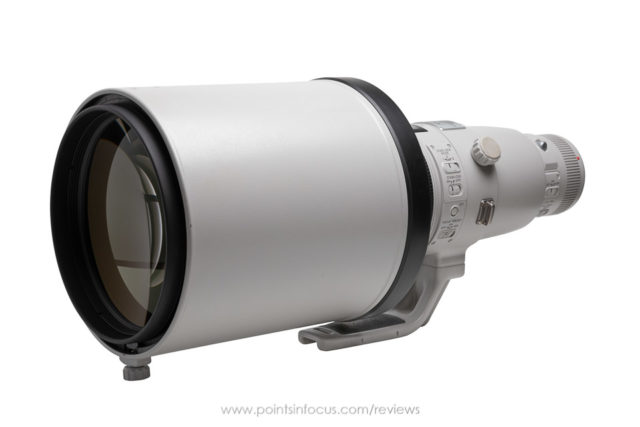
As for the cap, it’s not a traditional plastic clip on affair either. Instead it’s a large “soft” cover that attaches in place with a Velcro strap around the thumb-screw for the hood. Impact protection for the front element is provided by a rigid core under the fabric outer covering of the cap.
While the hood is really well built, and surprisingly light, it does pose some problems when it comes to traveling. It’s big, and that makes it unwieldy to travel with. If you want to pack the lens in a reasonable case, such as a Pelican Protector 1510 or a ThinkTank Photo/SKB ISeries 2011-8, the hood is going to make the already tight fit tighter.
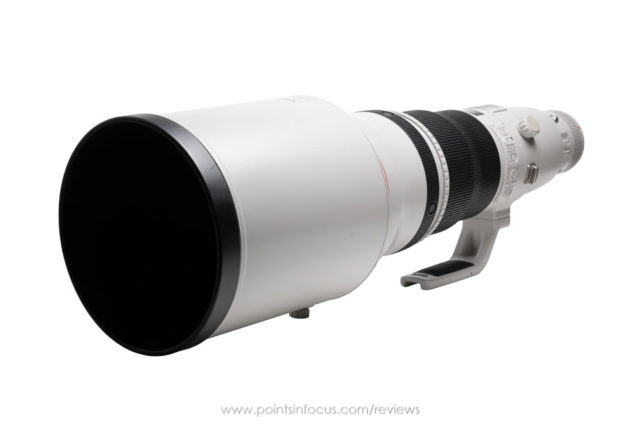
The best option might be just to find an alternative for use in the field, which is what I did and borrowed a Pelican 1510 and a Lens Coat Travel Hood. This worked great for transporting and shading the lens, but it’s also where I ran into problems with the Canon cover. Since the Canon cover is designed to be used with their hood, it doesn’t fit securely when you don’t have the hood in place. While you can tighten down the Velcro strap on the cover somewhat, you can’t quite tighten it down to stay on the bare lens real well.
Admittedly, Lens Coat also has a soliton for the hood problem with their “Hoodie” lens caps. These you can get sized for the lens itself and go about it that way.
It’s worth keeping the hood situation in mind if you’re considering renting this lens.
Challenges of a Big Telephoto Lens
This is the real meat that prompted me to write this article. It’s not a stretch to say that there’s a learning curve that comes with any new lens. Even if it covers a focal range that you know well, there is still an adjustment period to learn the quirks and performance characterises of that lens.
Unless you’re already shooting with big telephoto lenses, there’s very much an adjustment curve that comes with picking up a EF 600mm f/4L IS II USM.
It’s not that I’ve never shot at or near the same field of view. I regularly use a 1.4x teleconverter on my 100-400, yielding a 560mm lens. However, in many ways the 600mm f/4 is in a completely different class compared to much smaller lighter and slower 600mm range zooms.
For some reason, I’ve had a notion that these big primes, especially the EF 500mm f/4L IS II USM and EF 600mm f/4L IS II USM were a bit, maybe, magical in solving some of the problems I’ve had with my existing telephoto situation. I think my thinking was that by having a faster aperture and more raw focal length, it would address my running complaint about having to put an extender on an already slow lens to get the reach I was looking for.
To some extent, the 600 does solve some of those problems. However, in the process it introduces its own set of challenges too. While none are insurmountable by any means, they are something to be aware of; especially if you’re renting one of these lenses on a short time frame.
Size and Traveling
I’ll start with the great white lens in the room; size.
The EF 600mm f/4L IS II USM is a big lens. There’s really no two ways about it. Without the hood in place it’s not quite 18 inches (460 mm) long. With the hood in place, its more than 2 feet long not including the camera.
Packed for travel, this lens takes up the entire inside length of a Pelican Protector 1510 case. There’s still quite a bit of room left in the along side the lens but you’re not carrying it in a pelican case with a camera attached.
Secondly the lens alone is big enough that it won’t fit readily in most photography backpacks in any configuration.
For example with my ThinkTank Street Walker Pro, if you pull out all the internal dividers you can carry a 400mm f/2.8 with an attached body or a 500mm f/4 without a body, but not an EF 600mm f/4L IS II USM in any guise. The same goes for the ThinkTank Airport Commuter, you’d have to step up to the larger Airport Accelerator to fit a 600mm f/4 in it.
If you want to carry this lens in a backpack in a ready to go guise, there aren’t a lot of options. ThinkTank’s Glass Limo isn’t big enough, nor is their Airport Accelerator. You have to step up to a specialized long lens case of some sort.
To carry the lens with a body attached I used a borrowed Domke long lens case that doesn’t even appear to be in production anymore — also it’s not a backpack. The best looking option I can currently find in production looks to be Lens Coat’s Xpandable bags (or something similar). While it’s not a backpack, Lens Coat does offer a backpack strap for it so there is that.
Size and Weight; Impacts in the Field
To go along with the size is weight. The lens alone is 8.6 lbs (3.9 kg), add a pro-sized SLR and we’re talking about 11ish lbs (5kg) to hold or carry.
The first consideration that crossed my mind is can it be handheld?
The answer, maybe surprisingly, is kind of yes.
So first off, let me note that I’m neither a weight lifter or in particularly good shape. However, with that said, I was able to shoot with the lens handheld for short periods of time — though with a lot of help from the IS system.
That said, I would strongly argue that you don’t want to shoot handheld unless you have to. To get the most out of the optics, you really need to have as much in your favor as you can get. In this case, that means using a solid support. A beefy tripod with a good head is ideal. A monopod will certainly work, as will a beanbag on a solid surface, though in both of these cases you’ll be relying more on the IS system and high shutter speeds and will still be giving up some potential image quality.
When it comes to handholding the combination of weight, meaning you’ll be straining more, and the magnification of a 600mm focal length, means you simply won’t be able to max out the potential of the lens.
That said, realistically sometimes you just don’t have any other good options. And it’s under those conditions where the lighter mark II really shines over it’s predecessors.
In practice, I find that while I know I wasn’t getting the most out of the lens, the IS system and a fast shutter speed was good enough to net me a lot of good enough images while shooting wildlife in Yellowstone and the Grand Tetons. So it’s doable to use the lens handheld, but I would strongly discourage relying on it.
Aperture, Magnification, Depth of Field, and Sharp Images
As I noted, for many years now I’ve been shooting with an EF 100-400mm f/4.5-5.6L IS II USM and a TC. However, in that configuration (lens + TC), I always felt that I was running up against the slow aperture needing to shoot at higher ISOs and lower shutter speeds than I’d really like.
In my mind, having an f/4 prime, and one that gave me the same reach basic angle of view as my 100-400 with a TC, would just make everything so much better. Instead of shooting at ISO 3200 I could shoot at 800, or split the difference and get a stop more shutter speed to freeze motion.
In practice, what I found in my brief time with this lens, was that it poses as many challenges as I thought it was going to solve.
All of the exposure handles (aperture, shutter speed, and ISO) are interrelated and have both effects and side effects. A faster aperture setting will allow for a faster shutter speed at the same ISO, but does so at the cost of depth of field.
When shooting with long telephoto lenses, depth of field is almost always something that’s at a premium; especially with deceptively large wildlife. At 75 to 100 feet (23–30 m) with a 600mm lens at f/4 depth of field is less than 2 feet; at f/8 it’s less than 4 feet. For comparison, a bison’s horns can be 2 feet long.
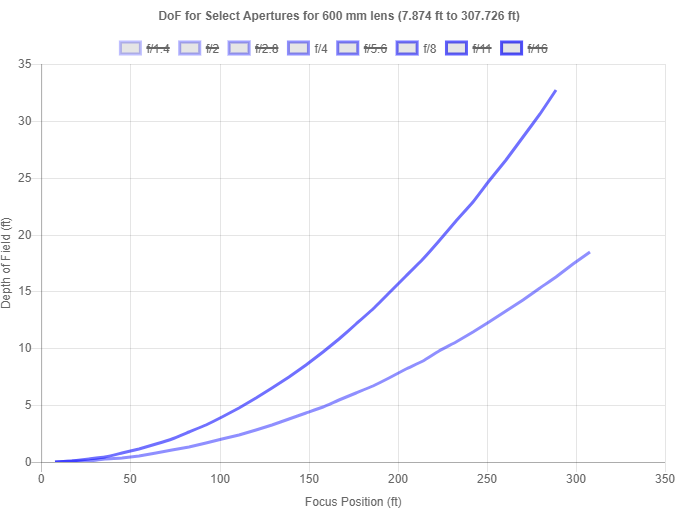
This is where the faster aperture can be both a blessing and a curse. On one hand, it yields a lot more flexibility for blurring backgrounds and getting that extra shutter speed. On the other hand, many times I had to stop down anyway to simply get the depth of field I need for the composition I want to shoot.
Then again, the faster aperture also means that with Canon’s current generation AF systems, I had a fully functional AF system with even a 2x teleconverter attached.
My point here isn’t that the faster aperture is a negative point; far from it. However, it’s also something you have to be conscious of if your use to slower telephoto lenses.
With Teleconverters
The place where the f/4 aperture — and the very high base image quality — really shines is when you pair the EF 600mm f/4L IS II USM with teleconverters. With a 1.4x teleconverter you have a 840mm f/5.6 lens, and with a 2x teleconverter you have a 1200mm f/8 lens.
To put some perspective at 1200mm, the moon will cover almost half of the narrow dimension of a full frame image, and 2/3rds of the narrow dimension of a Canon APS-C sensor.
Of course the image quality is degraded some with a teleconverter in place, even with Canon’s extremely good 3rd generation teleconverters. Moreover, at 840mm and 1200mm, even more care has to be taken with your setup and shooting conditions. Handholding at those focal lengths is an almost complete non-starter. At 1200mm even finding your subject can be a challenging proposition.
However, when shooting from a tripod, and especially when using a well balanced and controllable tripod head (a gimbal head is definitely ideal) good results can be achieved.
On a Tripod
To get the absolute best image quality out of the EF 600mm f/4L IS II USM, it really needs to be on a substantial tripod and paired with a good, well balanced, head.
For the tripod I used my Gitzo GT-3530LS. However, a beefier 5-series Gitzo, Really Right Stuff Series 4 tripod, or equivalent would be even better. That said, my 3-series Gitzo seemed to be more than adequately in terms of stability for the images I was shooting; even when shooting at 1200mm.
Tripod head choice is another issue entirely. While you certainly can use the lens with a ballhead — I used my Really Right Stuff BH-55 — it’s not ideal. Instead either a 2-axis fluid head, such as you would use for shooting video (e.g., a Manfrotto 504 or 509), or a gimbal head (e.g., a Wimberly head) is far easier to work with.
With the BH-55 I ran into two problems in the field. One is endemic to all ballheads, which is the balls ability to pan, tilt, and roll. The freedom to roll, which is great in normal situations, is more of a determent with a lens this large. You can deal with it, but it takes some added care when adjusting the lens.
The other problem I had was locking down the head when moving. The BH-55 is more than up to the task of dealing with the mass of the 600 f/4. However, the added mass does require tightening down the lock knob more than one might expect; or at least more than I was use to. Again, not a big issue, but something to be aware of.
Alternatives (Or Why I Rented a 600)
Ultimately, unless you have the budget to buy everything, you invariably have to come down to making a decision. Do you go (rent or buy) at 600 f/4, a 500 f/4, or something else. Obviously everybody’s situation is going to be unique in this respect, and there’s no one right answer. However, I want to talk a little about why I arrived at the decision I made, since the thought process might be useful.
For my trip to Yellowstone, I was unconstrained on what I could rent — so long as existed and was available at least. My cameras are a pair of full frame Canon bodies (2 EOS 5D mark IVs), and I already own a EF 100-400mm f/4L IS II USM and a 1.4x III TC.
My primary interest with this lens was obviously wildlife, with a primary hope for bears and a real tiny hope for some wolves. Regardless with any of the large animals that are found in the park, keeping a healthy distance isn’t a bad idea. Moreover, my primary concern is that many animals don’t necessarily want to be close to busy roads which would further necessitate needing to be able to reach out with a long lens.
Given my expectations of subject matter, potential working distances, and the available lenses, I could have gone with a 500, the 600, or even an EF 800mm f/5.6L IS USM.
Initially I was considering a 500mm f/4. However, I spend a lot of time shooting with my 100-400 and a 1.4x TC netting me a 560mm focal length, and it’s not usually long enough for me. It certainly would have been workable, but in thinking about it for a while it didn’t seem like it offered enough of a jump in capabilities over my 100-400 to make it worth the money or effort.
On the other hand, the 800 seemed to me to be less flexible. 800mm is a big step up from 560mm, and especially 400mm, and there’s no way to step it down to somewhere in the middle. In thinking through some setups I would be using, the 800 would likely mean keeping the 1.4x TC on the 100-400 and using that more often than not for anything in the 100-200 foot distance range.
On the other hand, a 600mm f/4 with a 1.4x TC is an 840mm f/5.6 lens, which does that job handily. And given the quality of the Canon lens and 3rd generation teleconverters, the 600mm f/4 with a 1.4x III TC produces an image that every bit as good as the 800mm f/5.6L IS USM.
For me it was the bit of added flexibility and balance of image quality and flexibility that really tipped the scales towards the EF 600mm f/4L IS II USM instead of the other two.
I could shoot the 600 bare for 600mm, put my 1.4x III behind it for and 840mm f/5.6, or a 2x III behind it for a 1200mm f/8 for when I really needed to reach out across a valley or lake to get a good view.
Moreover, the 600 paired well with my 100-400 on a second body. The jump from 400mm to 600mm was roughly equivalent to putting a 1.4x TC on the 100-400. To me that made it reasonable to keep the 100-400 bare, and just gab the 600 in an instance where I would have otherwise been putting a TC on the shorter lens. Plus I could add the 1.4x or 2x to the 600 when I needed even more reach.
To be honest, I think the choice worked out extremely well for me given the conditions and situations I found myself in. Over the time I was shooting in Yellowstone and the Grand Tetons, I shot 900 frames with the bare lens, 400 frames with the 1.4x TC and 400 frames with a 2x TC which I think is a pretty solid mix across the capabilities range. Though I had my 100-400 on a body almost all the time, it was quite rare that I ended up using it for wildlife.
Conclusions
This is where most reviews will say something like, “so should you get the xzy.” When you’re talking about a $1000 lens with a lot of alternatives, that’s a reasonable question. When you’re talking about a $12,000 lens; well, I don’t think you need my advice in making that decision.
On the other hand, for the majority of us, our exposure to using a lens like this is likely to be in the form of a rental. In which case the conditions and considerations are going to be different than for owning it. For example, we’ll have much less time to get accustomed to the lens, figure out the quirks, and that has ramifications on how well you can make use of the lens in the field.
That said, there’s always a question of where to draw the line. The reality is, you no longer need a 600mm f/4L to get a 600mm focal length. There are now acceptable quality f/6.3 zooms that get that long. For many photographers, the image quality of those is apparently good enough, and the size, weight, and especially price make them far more palatable.
Likewise, I’m writing from the perspective of a full frame user. While focal length is the metric that’s most discussed, it’s really angle of view that dictates how the composition will fall for any given subject at any given distance. On a crop camera you can get the same angle of view from a 400mm lens that’s smaller and lighter. For example, the EF 400mm f/4 DO IS II USM would provide the same base angle of view, and with the f/4 aperture give the same set of capabilities with teleconverters.
When push comes to shove, the best I can really do is try to explain what I see as the pros and cons of this lens, and the various close competitors. Ultimately what works for me may not be the best solution for your circumstances.
With that said, this experience has certainly tempered some of my dreams of owning an EF 600mm f/4L IS II USM, but not crushed them. I think it was absolutely the right choice for me to have taken to Yellowstone. Moreover, if I’m ever in a position to buy a big telephoto prime, I’m still strongly leaning to the 600 over the 500 for many of the same reasons that I outlined in this article. That said, an even smaller and lighter version, such as the diffractive optics version that Canon has demonstrated, would be even better.
Comments
Great article as I’m in that identical dilemma now heading to Teton and Yellowstone. I was hoping to see some of your pictures takin with 600 though. Thanks
Hi Jean,
I know right where you’re coming from, in wanting to see images. Unfortunately, the photographic results from my trip weren’t really up to my standards. Part of that was just the teething problems of working with this lens, part was that as a rental, I didn’t have time to really test it out and AF adjust it (assuming it was necessary). Finally, there was a lot adversity in the weather. Some days it was overcast all day, and I was shooting at ISO 6400-12800 which smothered detail. Other days it was so hot in places that I was getting pronounced shimmer form heat distortion. Finally, I’m working on a broader Yellowstone photography guide where I was intending to use most of the images anyway, but that’s taking me way longer to write than I had expected.
If you have any more specific questions or thoughts about gearing up for Yellowstone, I’d be more than happy to discuss them either here, or via email (you can use the contact form to send me an email).